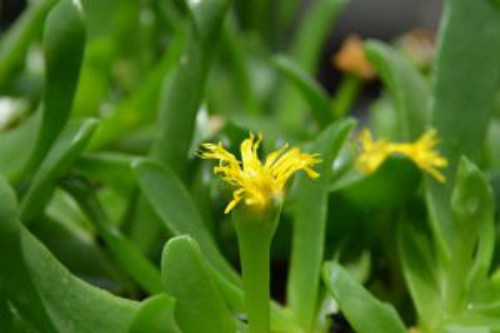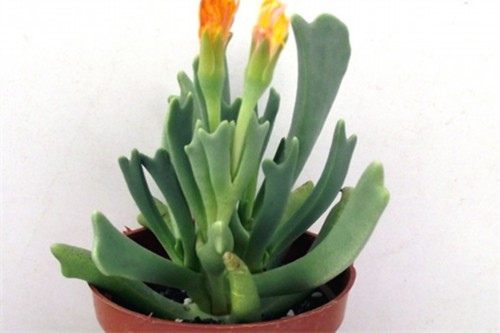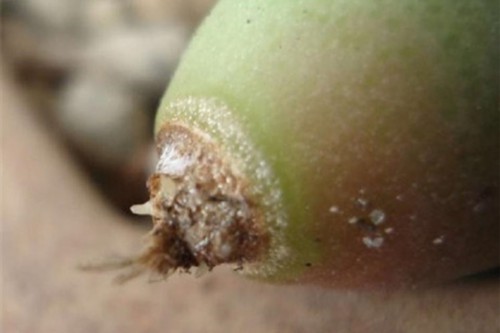Rhombophyllum nelii is one of the most representative succulent varieties of the genus Rhombophyllum. The scientific name is Rhombophyllum nelii, also known as Nel. s Rhombophyllum. This plant is a perennial succulent herb, belonging to the genus Tenebrio. It can reach 20-30 cm in height, the stem is short, many branches, the leaves are concentrated at the top of the branch, antler, slender and flat, the apex is bifid, the outer arc, the leaf color is light green to gray-green. The stems are long, the flowers are yellow, and the flowering time is summer. Native to South Africa, it likes warm, dry and sunny ecological environment, does not tolerate cold, and is suitable for growing on fertile loose, well-drained sandy loam soil.

How does Rhombophyllum nelii cut

Selection of cuttings: In the growing season, choose robust branches as cuttings, the length of about 10 to 15 cm. Ensure the cuttings are healthy and free from pests and diseases.
Treatment of cuttings: Remove the leaves from the lower part of the cuttings to reduce water evaporation and nutrient consumption. At the same time, ensure that the cut of the cuttings is smooth, which helps it to better root.
Preparation of cutting matrix: The matrix of peat soil and perlite can be selected in 1:1 ratio, which has good air permeability and water retention, and is conducive to the growth of cutting seedlings. A sand bed or a medium with a 1:1 ratio of vermiculite to perlite can also be used for cuttings.
Cutting: Insert the treated cuttings into the cutting matrix, the depth is about 1/3 to 1/2 of the length of the cuttings. Make sure the cuttings are firmly inserted into the substrate and do not wobble.
Maintaining humidity: After cutting, keeping the substrate moist is key. Proper humidity can be maintained by regularly spraying water or covering with a moisturizing film. Avoid substrate too dry or too wet, so as not to affect rooting.
Rooting and transplantation: About 1 to 2 months later, the cuttings should begin to take root. After rooting, the humidity can be gradually reduced to allow the new plant to adapt to a drier environment. When the new plant has reached a certain size, it can be transplanted into rich potting soil and gradually returned to normal management.

Rhombophyllum nelii is a succulent of the genus Rhombophyllum. Winter is the peak of its growth.
Rhombophyllum nelii is native to South Africa and prefers warm, dry and sunny conditions. The optimum temperature for growth is 18~24℃, and the temperature is too high, which will make the plant wilting.
Rhombophyllum nelii is not cold tolerant, drought tolerant and semi-shade tolerant, and can be sunlit all day and properly shaded during high summer temperatures. Keep the soil slightly wet during the growing period and water it once a week.
The common propagation methods are sowing and cutting.
< img SRC = "https://pinduoduo.news/pic/20240424/5240.jpg" Alt = "a sharp knife mess" width = "600" height = "400" title = "a sharp knife mess" align = "" style="text-wrap: wrap;" />
Change the pot: change the pot every 1 to 2 years, in the spring. The soil is changed at the same time when the basin is changed. The basin soil is mixed with peat soil and coarse sand, and a small amount of bone meal is added to the soil.
Watering: Water meat moderately during the growing season, once a week. When the summer temperature is high and the air humidity is low, it is necessary to add water in time, and the air humidity can also be increased by spraying. Keep the soil dry in winter. In addition, the flowering period needs to be properly supplemented with water, otherwise the flowers are easy to wither.
Fertilization: Fertilize once a month during the growing period.
Pests and diseases: During the flowering period, the plants are weak and vulnerable to aphids, which can be sprayed with 50% of the solution 2000 times. Quick knife mess will also be affected by leaf spot, brown spots on the leaves, can be sprayed 65% mancozeb wettable powder 600 liquid for prevention and control.
< img SRC = "https://pinduoduo.news/pic/20240424/5237.jpg" title = "a sharp knife mess" Alt = "a sharp knife mess" style = "text - wrap: wrap;" />
Sowing: sowing in spring, the temperature is controlled at 19~24℃.
Cutting: When the plant is growing well (growth period), cut the branches with leaves for cutting, and dry the branches in the shade for 1 to 2 days, insert them into the sand bed otherwise the branches are easy to rot. After cutting, keep the basin soil slightly wet.
Planting combination suggestions: according to the wave, white Buddha Jia.